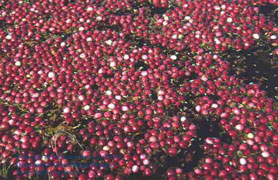


Home
Flowers &
Indoor Plants
Fruits & Nuts
Ornamentals
Vegetables
Special Topics
Resources
Glossary

Cranberry |
 |
What about it? The cranberry is an acid-loving, close relative of the blueberry. These tart berries are high in Vitamin C, and are enjoyed greatly around the winter holidays. The plants are vines with very specific site requirements. They are native to this country, and are grown commercially in Masssachusetts, Wisconsin, Washington, and New Jersey. What is it used for? Many people associate cranberries with jellies and sauces used during the fall and winter holidays, but cranberries are also used for freezing and canning, and in juices, breads, snacks (fruit leather) and yogurts. Where does it grow? How do we grow it? Cranberries are very choosy about their site requirements, so although they are widely grown in the Northeast, they appear in very few home gardens! An ideal site for growing cranberries will have the following characteristics: 1) a peat or sandy soil; 2) a large supply of fresh water for frost protection, irrigation, and winter protection, 3) a convenient supply of coarse sand for applying to the bog; 4) an elevated site that will encourage air drainage; and 5) an area with sufficient slope to permit drainage of excess water from the area. What are its primary problems? Diseases common to the cranberry include false blossom disease, black spot, and twig blight. The most serious disease problems of cranberries are caused by the fruit rotting fungi. These fungi cause diseases such as end rot and bitter rot. Cranberry plants are attacked by many different types of insects. The most common are cranberry tipworm, black-headed fireworm, scale insects, cranberry girdler, and the cranberry fruitworm. How do we harvest and store it? Berries are machine harvested either dry or 'on the flood'. Dry harvest involves stripping fruit from the vines by mechanical rakes that pass through the plants; harvesting 'on the flood' floats the unharvested berries from the bog floor, where they are then removed by machine. The cranberries that we purchase in the winter months in supermarkets tend to keep quite well at cool temperatures for as long as several weeks.
© Copyright, Department of Horticulture, Cornell University. |




